
This is how I saw Yellow Banks at Santa Cruz Island on my first boat dive. Click on it for a larger image.
|
This is another of my sort of rambling stories. Really, I started
it to write about what was a good dive, but the most notable
point of the trip was the rusty old boat we went on. As I wrote and
as I thought about it, I could see that there was another part
of the story that was about the dive industry of the time. It says
something about the boats and crews when the dive industry was in
its childhood.
|
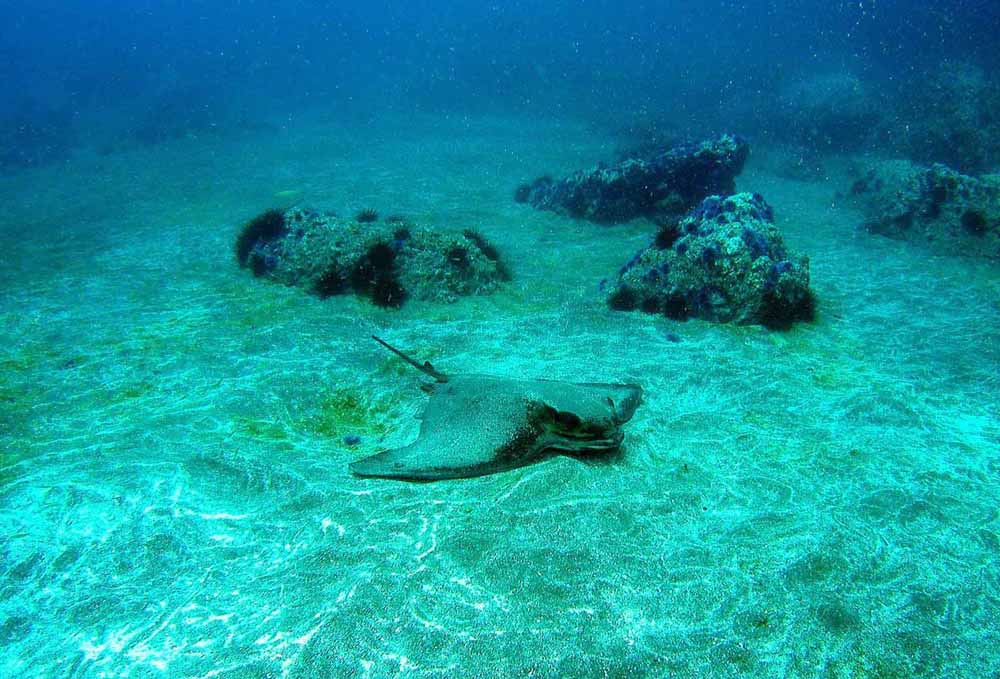 Bat Ray in the sand outside the reef
Bat Ray in the sand outside the reef
|
And then there was the Emerald.
Anybody ever dive on the Emerald? What about you Frank? You've seen the picture, "Then and Now" that shows the two divers. The "Then" diver has some funky old gear and is holding up a huge fish he shot. The "Now" picture shows a diver with tons of advanced gear and a gun like a scoped bazooka, but the fish looks like bait. Well, this was "Then". The fish were big and thick. From what I understand, the Emerald was something like the third boat built on the west coast with an all steel hull. Something like that. In any case it was old. There were pictures of it from the 1920's, but in the pictures it seemed like it had far less beam then than it does now. Alex, the skipper, related how the previous owner, Glen Miller, had researched back to when the boat had been used to haul lumber in Lake Tahoe. He actually met the old owner, who was too senile to understand that the boat was still in service. He was convinced that the Emerald was still where he had run her aground when they started taking on water many many years before. Alex told us, she really put the word 'old', in old funky boat. Glen Miller had built a new, the boat Coral Sea for treasure hunting. He explained that the mistakes of the Emerald were not repeated in the Coral Sea, meaning there was room to get to the engines. |
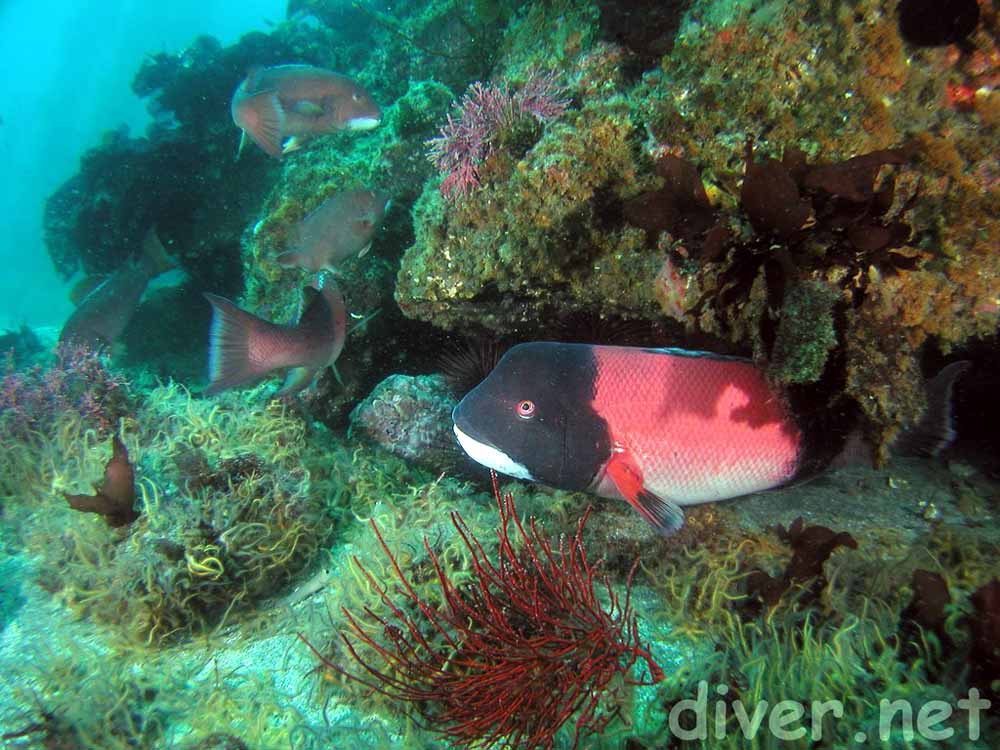 Typical front side reef scene with big male SheepHead
Typical front side reef scene with big male SheepHead
|
Yah, it was a funky old boat, but it was great for a 2 day UC Santa Cruz
scuba club charter to Santa Cruz Island. This was the mid-70's when the
island had suffered only a soft touch from divers. The bottom was still
carpeted with big Red urchins before any commercial harvest had begun.
Large abalone were common enough if looked for, though the commercial
harvesters had been through a fair amount and were working Santa Rosa
Island in good weather. There were scallops in the cracks behind the urchins,
most coves near
swarmed with 8 to 10 pound sheepsheads and the Calico bass were everywhere.
It wasn't really much of a hunting crowd on this trip. Partly, it was a long
trip home to Santa Cruz and then for many people, what are they
supposed to do with the game when they do get back to their
dorm room. Partly it was that that just wasn't the diving culture of the
group. A lot of these divers were club people that dove together
regularly in Monterey and Big Sur. Bob Widman was the university dive instructor and
promoted a very active dive club. I should mention that Bob set a high standard for macho
dive instructors and was a bit of an ass. We had already had disagreements and that
was why I rarely dove with the UCSC dive club. Actually, he disliked me some before
we met, because he had known my sister when she went to the school before me. Even
if she hadn't, we would not have gotten along for very long on our own.
|
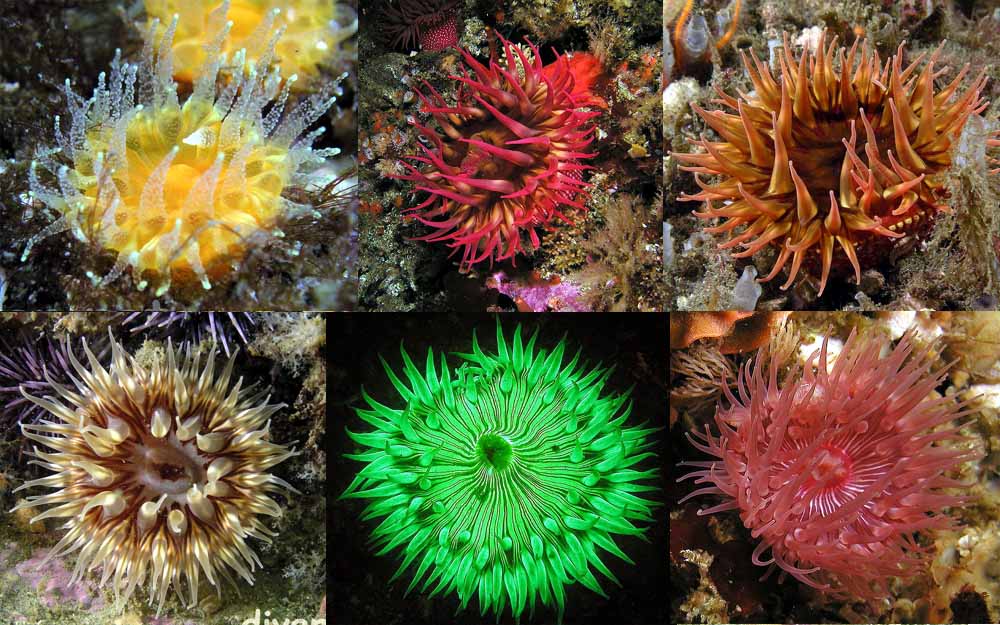 The reef holds anemones of every size and color
The reef holds anemones of every size and color
|
I suspect it was to discourage me from coming that I was told I could get a ride back,
but there was only room for my gear to get there. I would have to find my own way to
Santa Barbara before the 4:00 AM departure so I hitch hiked. Getting down Hiway 1 to Salinas was
easy, but it was hard getting out. I had to walk through town some to get to an onramp
for the 101. From there it was easy until I got let off at the truck stop just north
of Paso Robles. It was a warm night so it wasn't so bad. What was discouraging was
reading the graffitti on the big street light left by previous travellers. Some were
a bit poetic. Most were rather dispairing. Under a smiling skull and crossbones was
the lament "Tried to get a ride, finally f***ing died". About 11:30 a bored trucker
coming out of the diner picked me up and took me on to Santa Barbara. I was pretty
wired walking through the quiet streets to the dock.
The morning crossing was a little rough and Alex opted to go west along the front of Santa Cruz Island as there was supposed to be more weather coming in. Now it was sunny and clear, beautiful Fall conditions. The front side was just a little rough from the weather coming from the north and west, but not too bad so Alex pulled in just east of Scorpions in the wave shadow. It was a classic front side dive. We anchored about 60 feet from shore in a kelp bed. Looking at the kelp in the blue water, you could follow the kelp down with your eye and see the rocks at the bottom. It was only about 35 feet deep here. We finished gearing up, listened to Alex give a site description and the gate was open... but then Bob Widman gave his dive briefing and said that absolutely everyone had to be with a buddy at all times. I figured that was going to be an annoyance. I was used to diving the area, but it was usually with a boatload of very aggressive hunters who were almost all solo diving. This college crowd was pretty different. Most divers were from casual to timid. Well, I could buddy dive if I had to and usually did until the buddy ran out of air or got lost. I got lined up with a guy named Kevin who was trained by Bob, so he considered buddy diving normal. He didn't think much of me and I found out later that Bob had warned the scuba club about me. |
 A close look at the reef always shows numerous colorful, but shy Christmas worms
A close look at the reef always shows numerous colorful, but shy Christmas worms
|
Finally, the gate was really open.
I was in a thin beaver tail wetsuit, but the water felt warm and was great as we entered. On the bottom though, we were where the sand and the rock reef met. There was a pretty good current running over the sand and we had to hustle to get in the rocks where there seemed to be no current. The rocks were covered with urchins and anemones. There were lots of fish and some very big purple sunflower stars with 20 arms each. These were the real hunters of the reef. We headed in shallower to where the fallen rocks from the cliff started. The kelp was thick and there was a lot of feather boa kelp. Right at the cliff, there was almost no kelp as it rubs off against the rock cliff. In the shallows were bass, perch, kelp fish and garibaldi. The colors were green from the eel grass in the shallows. On the cliff itself was a thick growth of everything including mussels, anemones, pisaster stars, scallops, tunicates, urchins, snails, sponges and a lot of stuff I couldn't identify. You could look up and see the shoreline, but from below. At the bottom of the cliff under cracks were octopus gardens, piles of shells dumped from previous meals. |
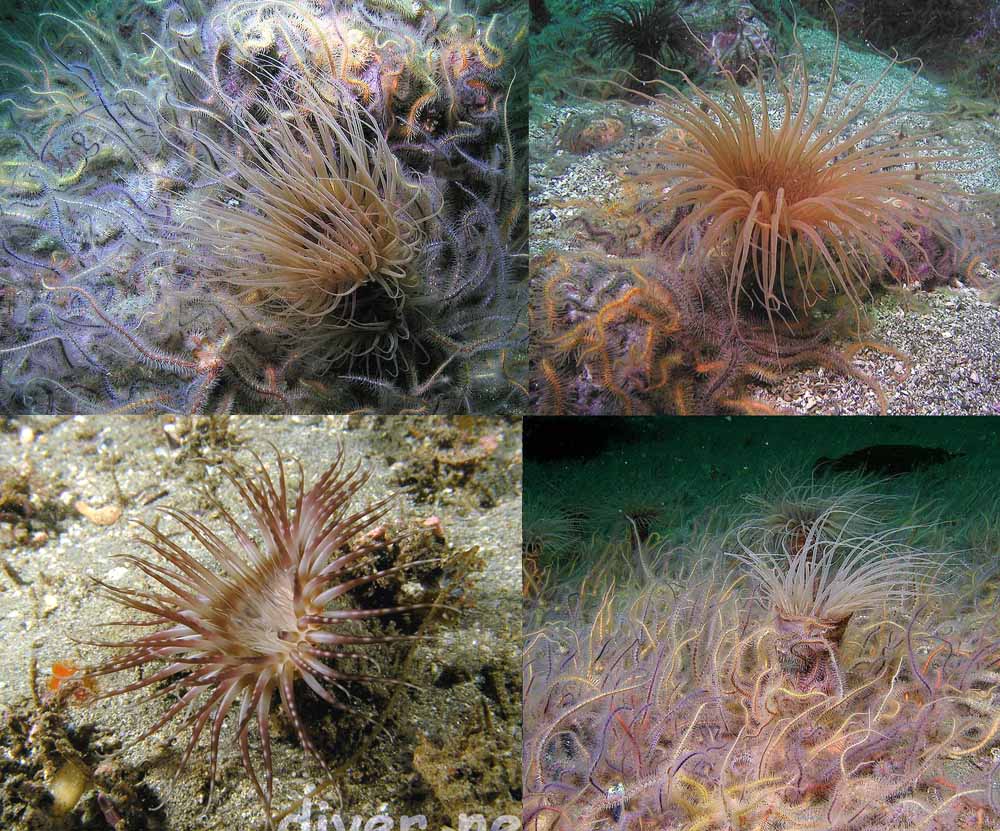 Delicate Tube Dwelling Anemones are common in the sand amoung
the even more delicate Brittle Stars
Delicate Tube Dwelling Anemones are common in the sand amoung
the even more delicate Brittle Stars
| We moved along the cliff in the rocks at about 20 feet until we came to the point at the western end of the cove. It stuck out about 75 feet from the cliff and was basically just a large rock pile from waterline to the sand at 40 feet. It was covered with red coraline algaes and short brown algae growth. The curent moved back and forth around it. The large holes between the rocks were just black caves that large fish appeared out of and languidly vanished into. It was full of big fish of all kinds, but that was because they could just swim a couple feet and they were completely hidden from view. It was exotic because of instead of the browns, golds, greens and reds of the sunny reef, this was all black and grey in the dim rocks shadowed from the light by the steep cliff and the offshore rocks that stuck up at the point like teeth. Even the water seemed cooler and it was easy to feel the current just outside the rocks that would whip a careless diver out along the sand and down the island. |
 |
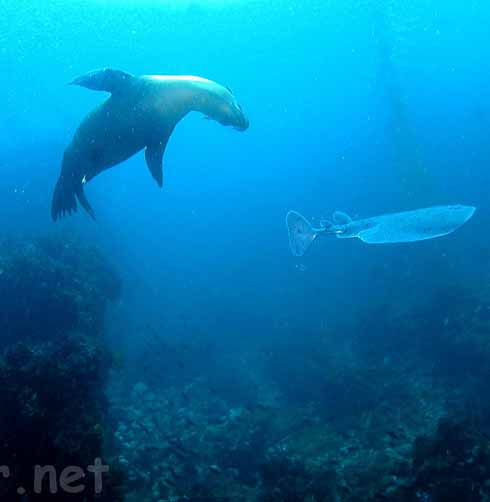 |
They are usually quite willing to play, especially the short fat yearlings.
Don't play with the electric Torpedo Ray though.
|
We moved back into the cove some, inside the protection of the point. It was sunny again above the rocks that went down to the sand. 20 feet from the cliff it was again a thick kelp forest full of big sheepheads. We moved to the outer edge of the reef and drifted back in the current. In the sand were a couple of Bat Rays. I showed Kevin where the pink abalone hang out at the base of the rocks, half in the sand at the edge of the reef. It was a great dive, but we came up so that we didn't pass the boat in the current. Nice Dive. Diving looked OK to me, but it was obvious that the current was growing and after the dive Alex decided to continue on to get behind the island. We came around San Pedro Point and things calmed considerable from the swell on the front side. On the island could be seen the orchard at the west end. Ahead a couple miles were the cliffs of Yellow Banks. Here was the big cove that was the east end of Santa Cruz Island. There were lots of signs of the humans that ranched the area. |
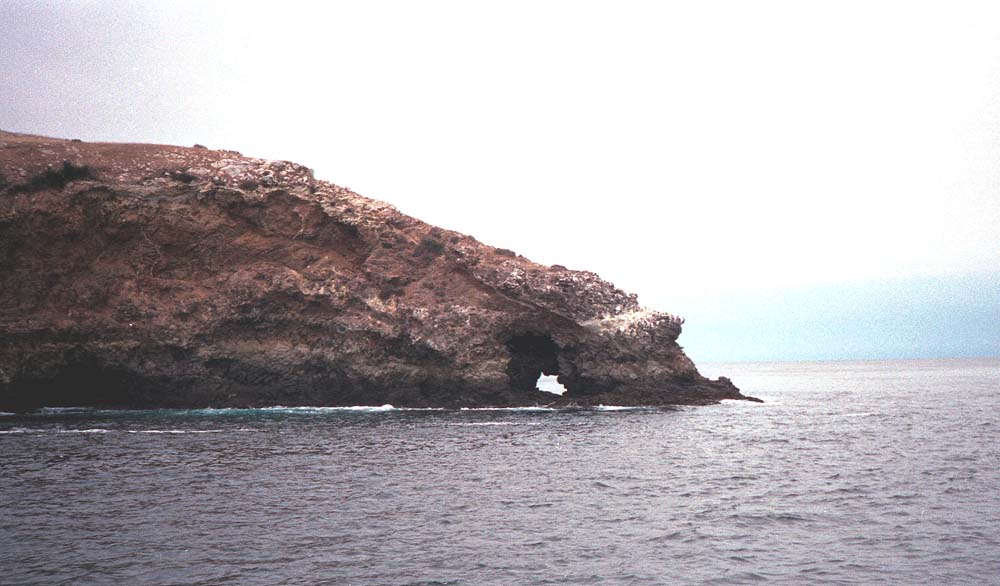 San Pedro Point
San Pedro Point
|
Alex continued on and took the Emerald up around the corner to Yellow Banks. Great!.
This was familiar territory
to me. I had spent the last couple years diving from the Sea Bee here. Yellow Banks on
the south east corner of the island, named after the yellowish cliffs that are just
visible from the mainland on a clear day, is an amazing and vast kelp reef with good diving
extending from shore out about 3/4 mile to past 120 feet. Overall, it probably comprises
a couple square miles of prime diving and the area continues past that southwest along
the shore for miles. Sure enough, he anchored right in the middle of the main reef in
about 40 feet of water. I knew this area well. It's great diving. I told my buddy to
follow me and we would make a large one tank loop. I also said that when I give him a
tilted flat hand as a signal, notice how everything changes.
|
 |
 |
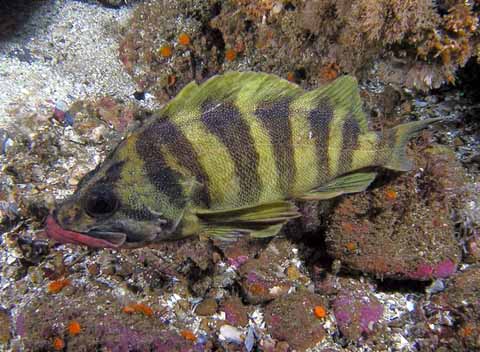 |
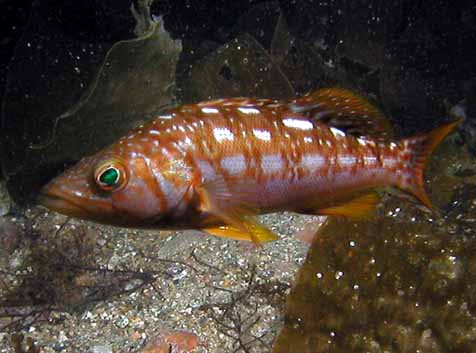 |
Kelp Bass, Sculpin, Tree Fish, Calico Bass.
|
Though you could see the weather further out, it was calm and flat over the inner reef.
The kelp was up so there was no noticable current. The water looked clear when we jumped
in. The bottom was at 35 feet and large broken rocks thickly covered with green, red and brown
algaes. The rocks underwater are layered like the layers visible in the shore geology and so
there was shelf after rock shelf for habitat. The water was clear and shallow enough
to be brightly lit by the morning sun. I headed straight out so that I would get a bit
deeper and at the same time cross the grain of the reef.
|
 Starfish are the hunters of the reef.
Starfish are the hunters of the reef.
|
There were lots of cowrys,
stars and occasional pink abalone in the many shelves. Big red Franciscanus urchins were
everywhere. You can look close at all the kelps and invertebrates in the rocks or look a
bit back and see all the perch, bass, sheepheads, rockfish and assorted finners around
the rocks. Every so often, there were various sized scallops, but the big ones were
usually hidden from hunters in cracks behind the big Red urchins. I was looking in rocks
and saw a few large swell sharks. The variety of life
just goes on and on. I was basically just slowly cruising it so my buddy would keep up,
but I was covering territory with a destination in mind.
|
 These are even more fun to hunt than they are to eat.
These are even more fun to hunt than they are to eat.
|
Then I found what I wanted. There was a ledge that dropped off about 10 feet to an area
of course white sand. This was something of a break in the reef and is what I always
looked for here. The water temperature was just a little bit cooler, but this was a totally
different ecology. This was the place of large brown kelps and big sheepheads. It was
too deep for the red and green algaes. Instead there were large macrocystis and the big leaves
of elephant ear kelps laying along the bottom. The reef colors changed from light golden
to dark brown. This was where I always found the big red abalone along the
sides of the sand channnels. I wasn't going to take game on this trip, but I was certainly
in hunting mode looking for them. I signaled my buddy to stay low above the sand, next
to the shelves. Right away we saw some lobsters that would have been a nice find in season.
There were lots of large male sheepheads with their sharp red, white and black markings.
On another day, some would have gone in my bag. There were less fish here, but they were
bigger. A a big bat ray drifted out of the gloom under the thick kelp above the reef.
Then I saw the treasure I'm usually looking for. There were three big red abs, all about
8 1/2 inch or so fattys. Maybe next time.
|
 Abs are the ultimate yuppy food.
Abs are the ultimate yuppy food.
|
It was time to make the first turn so I got Kevin's attention and headed east up over the
reef through the thick kelp. The rocks run in ledges that seem endless and vanish from
sight. When hunting them you race along wondering what is just a bit further. It was
slower today, but there is endless different life to see. One area would be full of purple
urchins or giant Picnopodia stars and then you wouldn't see any more for the rest of the
dive. At that time, I could only identify the commonest fish and invertebrates. Those days
were about hunting.
|
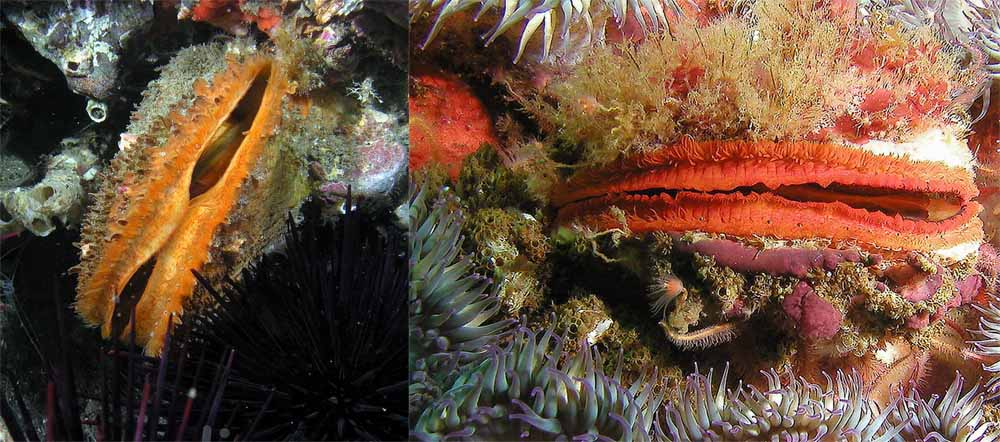 Scallops are delicious sauted or eaten fresh underwater.
Scallops are delicious sauted or eaten fresh underwater.
|
Soon, it was time to turn north towards the greens and reds of the shallows. I didn't want
to go too near shore, but we were seeing emerald eel grass full of tiny cockroach lobsters.
Then another turn south west until there was no air left to speak of. We came up about 100
feet from the boat. What a great dive, but the wind was starting just a bit.
Alex moved the Emerald up to Blue Banks where we made a couple dives. That is always a beautiful area with extensive reefs. On an otherwise mostly flat reef in 45 feet of water, I found one rock mount that rose straight for 25 feet and was about that much across. It had a crack in one side that would have been big enough for a person to fit into if it hadn't been full of fish, mostly big bass and sheepheads. 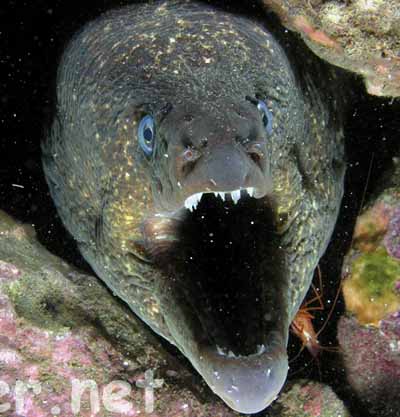
|
 Sunsets need no explanation
Sunsets need no explanation
|
The next day dawned a bit rougher than the first. The swell was coming from
the north, so Alex kept finding us dive spots on the backside where it was
moderately calm. It was a beautiful morning though and the vis was excellent
again. We started the morning with a dive on an offshore reef at about 60
feet with really good kelp.
The next stop was for a couple dives at the large reef area of Gull Island. It was a bit rough, but full of life. There were an amazing number of crabs, numerous abalone and lots of fish. It is also a good place to look close and see colorful Nudibranchs. |
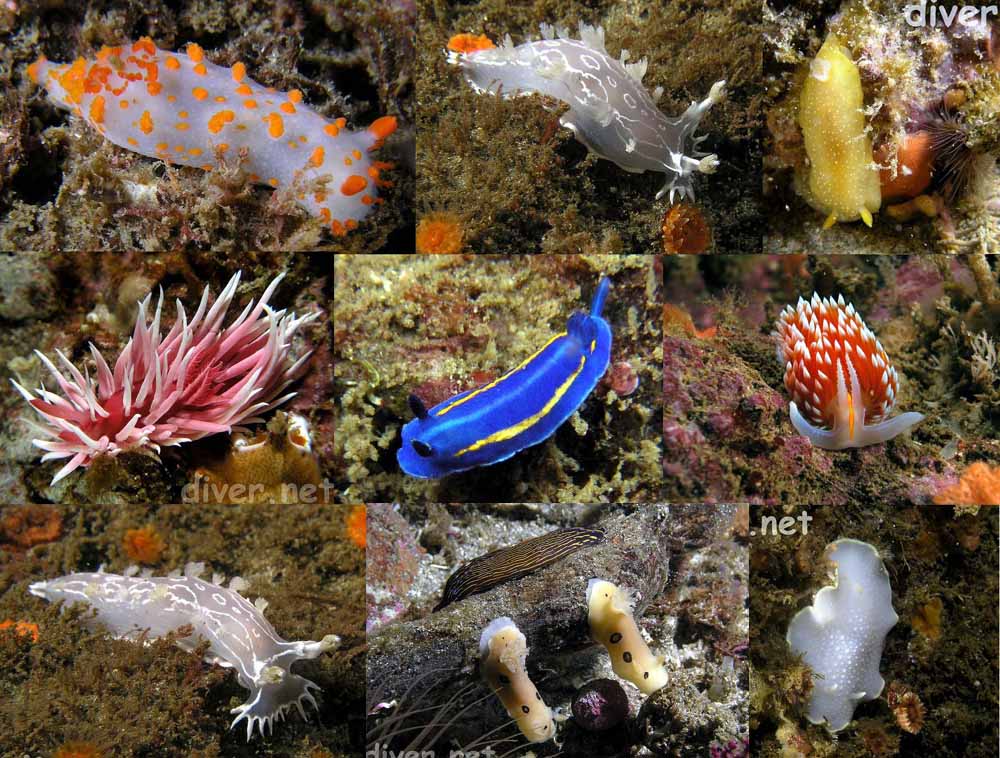 You have to look close, but it is well worth it.
You have to look close, but it is well worth it.
|
I had made my first 2 dives with the same buddy as the day before. He knew
that though I mostly stayed with him, I had a fair dislike for the
buddying up. On the second dive we got pretty well separated. He didn't
much care and still Bob Widman never really figured out that that I was
not religiously buddy diving. But my buddy was done for the day. I
figured that I had 2 more dives to do, so I sorta asked if anyone
needed a buddy. At that point it was not an issue. While many
people were done diving, there were divers still going in and I'm sure I
could have worked out a buddy, even if it was a 3 some. Though it was
not my intent, I probably said something about diving without a buddy. At
this time Bob decided to get huffy and be a jerk and pester me about
buddy diving. I said that I really didn't care about a buddy and he
replied that I was going to dive how he told me. I said I signed a
waiver and I'll sign whatever he wants. He then said 'I say who dives
and who doesn't'. I replied 'no you don't, Alex does'. That was the
exact last thing that Alex wanted to hear, but Bob was enough of a boater
to know that it was basically true. The skipper has the last word and
that's that. Well Alex replied 'no one dives that I don't think is safe'
and that was the end of the conversation and the beginning of a fairly
developed dislike of me by Bob. At 19 I had probably done more dives at
the Channel Islands than anyone else on the boat and Alex knew that and
quite well understood my nature as a diver. Bob didn't bother to talk to me
any more and I didn't bother with a buddy for the last 2 dives. It was great
to open it up some and swim with my full attention on the beauty around me.
|
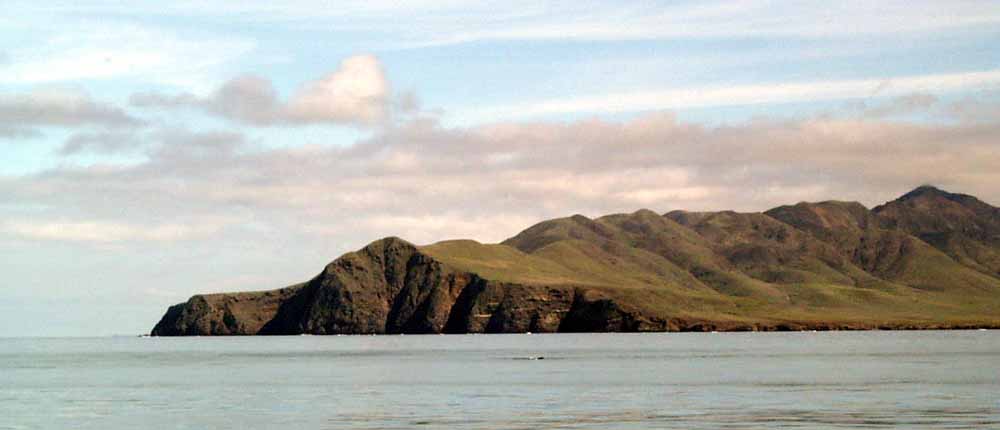 The cliffs on the north side above Frazier Point. Great diving there.
The cliffs on the north side above Frazier Point. Great diving there.
|
It was the end of the diving.
We headed back to Santa Barbara by going north up the backside of Cruz,
between Santa Cruz and Santa Rosa Islands. The west end of Santa Cruz Island
there is notoriously rough and so has earned the nick name 'The Potato Patch'.
Waves come from all directions there and make it choppy... giant chop.
Everybody was sick or near enough to it that Alex was on the deck trying to
juggle oranges to amuse people and make everyone forget how bad they felt.
It was funny because he could juggle for a while, but inevitably, the
rocking of the boat would suddenly change and the oranges all took
of in different directions as Alex moved under them.
|
 I hate to go home
I hate to go home
|
Now this is a bit of a story about some really beautiful diving when
Santa Cruz Island was lightly enough visited for it to look unspoiled,
but for me there are more storys than that here. Partly it is the story
of this funky old boat, the Emerald, that is part of California Diving
History. Partly it is a story about when diving was a younger sport.
This was before ScubaPro started to sell BC's.
There is more of this story to think about though. Things were different then. Heck, it wasn't until about 1972 that the Coast Guard allowed fills on a boat to go to more than 1800 pounds. The SeaBee had K bottles on board instead of a compressor. That was even less than we needed for a real fill in our steel 72's. That was OK. The diving was shallower and we made do. Dive boat operations were completely different then. The boats and crews were smaller. On some boats, like the Sea Bee, the Skipper had no background as a diver or as a dive operator. There was no such thing at that time. He was the skipper and the deck hand. There might be a cook. Only Truth aquatics had a business model. Some of the boats had histories as fishing boats, but most had no history as a sport boat. Most of these skippers were just working sea men that went into dive charters as a business or else they were just divers that started a dive charter business because they loved diving. It was the same way for the deck hands. They may or may not have had any experience with diving and divers. This was not a way to get rich. It wasn't even a very good way to make a living. Mel Fisher may have started the dive charter business on the west coast more than 10 years earlier, but at this time, it was still an infant industry. It meant long hard days. More than once, about 3 pm, on a day that started at 3 am for him, as we came up the backside of Cruz from a day at Rosa, Art would sort of change places with me instead of just falling asleep at the helm. 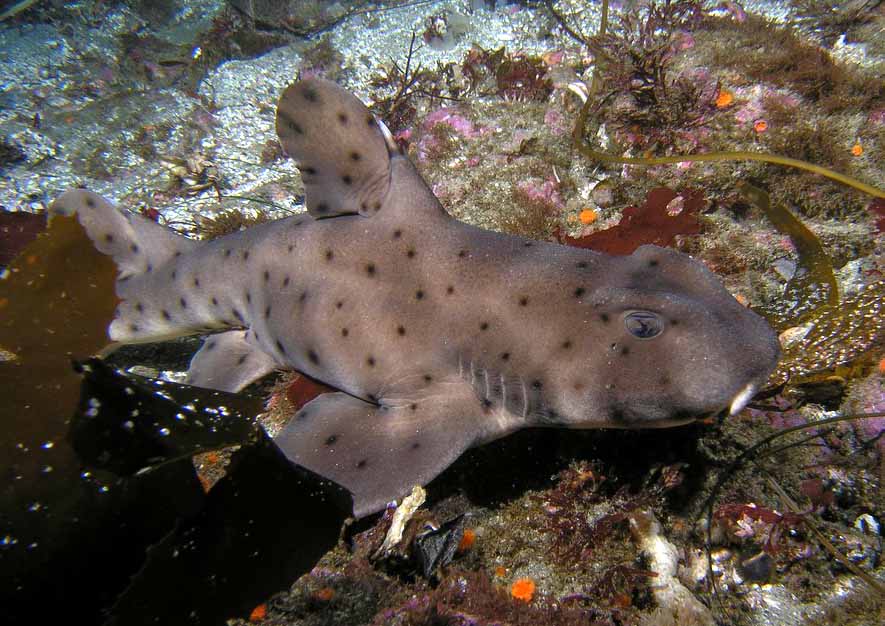 Horn Sharks are cute.
Horn Sharks are cute.
These days we are more used to dive operations that use bigger boats with more than one skipper aboard and gear that the early dive boats just never considered feasable. What this story should really be about is the skipper of the Emerald, Alex, and so many other skippers of dive boats. These are not the boats that ran as big businesses for years and years. These were the boats that were scraping out a living in a niche that just didn't exist before. Obviously, I liked the diving then. All the life was more abundant, especially the game. It seemed like the kelp was healthier and thicker. That was when we did kelp swims to get over kelp beds too thick to swim through. These days I never paddle through kelp as thick as I did then. In those days, you didn't ask if there were hot showers, you asked if there was an onboard head. The divers tended to be arerospace engineers and according to lore, 'people kicked out of motorcycle clubs for being too crude'. |

The Mighty Spanish Shawl |
|
Of all the people in a tough business, I think it was hardest on
the boat owners who were trying to make a living in one of the
most difficult places to do that, the ocean.
There was another side to this. Some of the dive boat operators,
the ones that got into the business because they loved diving, they
got opportunities to dive and see the islands that most of us would
never imagine.
|
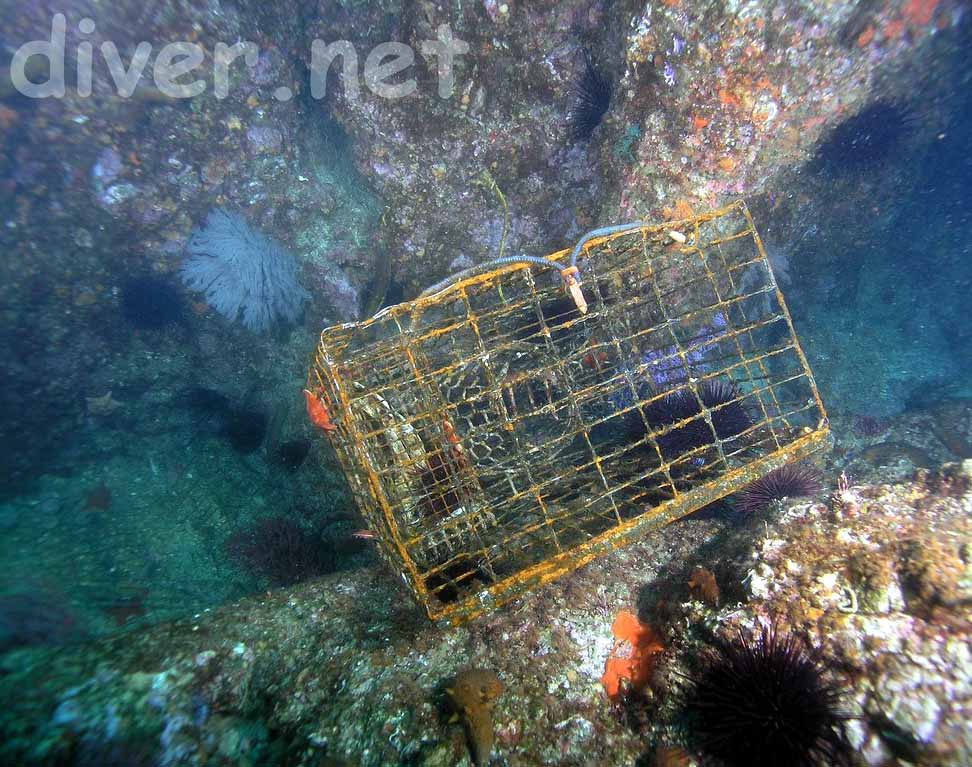 Abandoned Lobster Pot
Abandoned Lobster Pot
|
Not only did they have their secret spots, they were there on those
special days when they would say "We're scheduled for Santa Cruz Island,
but with weather this calm, I'm afraid we're going to have to go on to
Santa Rosa or San Miguel Islands. Is there anyone that can't get back a
little late?". A lot of times, they took out their boats themselves when
no one was scheduled to go. I read the story by one deckhand of when they
went on Santa Cruz Island by invitation. They were taken on a long
horseback ride to an overlook that showed all the islands.
Diving is a sport we do because we love it. There is a price for all things and many of us have paid dearly and sacrificed much for our great love of diving, but none more than the small charter dive boat owner. Enjoy the diving, seahunt |
 Relax and look around
Relax and look around